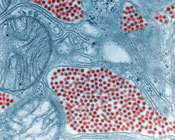Eastern equine encephalitis virus (EEEV) was first recognized in 1831 in the United States when 75 horses died of encephalitic illness in Massachusetts. Today, EEEV is present in North, Central, and South America, as well as the Caribbean. The first confirmed human cases were identified in 1938, when 30 children died of encephalitis in the northeastern United States (these cases coincided with outbreaks in horses in the same region). The fatality rate in humans is 33% and there is currently no cure for human infections.
The virus is capable of infecting mammals, birds, reptiles, and amphibians, and it is maintained in nature through a bird-mosquito cycle.

Vector insects
Two mosquito species are primarily involved in the first portion of the cycle, feeding on the blood of birds and maintaining the virus in the avian population:
- Culiseta melanura
- Culiseta morsitans
Transmission of the EEEV to mammals occurs via other mosquitoes (bridge vectors) that bring the virus from avian populations to mammalian populations. They include:
- Coquillettidia perturbans
- Aedes canadensis
- Aedes sollicitans
- Aedes vexans
Generally, transmission occurs only through the bite of an infected mosquito — infected mammals do not circulate enough virus in their blood to infect additional mosquitoes.
Resources
Learn more about Eastern Equine Encephalitis Virus disease
Product selection dependent on vector biology and ecology
Quick Links
Contact a Valent BioSciences public health representative.
Contact Us